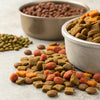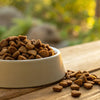How Much Dry Food Should I Give My Dog? A Comprehensive Guide for Pet Owners
- Houndsy
Table of Contents
- Introduction
- Understanding Your Dog's Nutritional Needs
- Calculating the Right Food Portion
- Types of Dog Food and Feeding Strategies
- Monitoring Your Dog’s Health and Weight
- Key Takeaways
- FAQs
Introduction
Did you know that about 56% of dogs in the U.S. are considered overweight or obese? This alarming statistic emphasizes the crucial role that proper nutrition plays in our furry friends' health. As responsible pet owners, we all want to ensure that our dogs receive the right amount of food to support their health and well-being. Yet, the question remains: how much dry food should we give our dogs?
In this blog post, we will explore the various factors that influence how much dry food our dogs need, from their age and size to their activity level and health status. By the end of this guide, you'll have a clearer understanding of how to determine the right portion sizes and feeding schedules for your beloved pet.
So, have you ever thought about your dog's feeding routine? Are you confident that you're providing them with the optimal amount of food? Let's dive into the details to simplify this essential aspect of pet care.
Understanding Your Dog's Nutritional Needs
When it comes to determining how much dry food to give our dogs, we must first understand their nutritional needs. Dogs require a balanced diet that includes proteins, fats, carbohydrates, vitamins, and minerals. Each component plays a vital role in their overall health:
- Proteins are essential for muscle growth and repair.
- Fats provide energy and help in the absorption of vitamins.
- Carbohydrates supply fiber to aid digestion and maintain gut health.
- Vitamins and minerals support various bodily functions and overall well-being.
Factors Influencing Food Intake
Several factors can affect how much dry food is appropriate for our dogs:
- Age: Puppies, adults, and senior dogs have different nutritional requirements. Puppies need more calories and protein to support rapid growth, while senior dogs often require fewer calories to maintain a healthy weight.
- Size: Larger breeds generally need more food than smaller breeds. The specific requirements can vary significantly based on the dog's weight and size category.
- Activity Level: An active dog will burn more calories and therefore require a higher food intake compared to a more sedentary dog.
- Health Status: Dogs with underlying health conditions may have specific dietary needs. For example, a dog with diabetes may require a specialized diet to manage their condition.
- Body Condition Score (BCS): This scoring system helps evaluate whether a dog is underweight, at an ideal weight, or overweight. Adjustments in food intake may be necessary based on this assessment.
- Type of Food: Different dog foods have varying calorie densities. For instance, some premium brands may be more nutrient-dense than others, influencing the amount we should serve.
Calculating the Right Food Portion
Using Feeding Guidelines
Most dog food brands provide feeding guidelines on their packaging. These guidelines typically offer recommendations based on the dog's weight. For example, a feeding guide may suggest:
- For a dog weighing 10 to 20 lbs: ¾ to 1 ⅓ cups of food per day.
- For a dog weighing 30 to 50 lbs: 1 ¾ to 2 ⅔ cups of food per day.
- For a dog weighing 60 to 100 lbs: 3 to 4 ½ cups of food per day.
It's essential to note that these are general guidelines and may need to be adjusted based on your dog's unique circumstances.
Caloric Needs Calculation
To calculate the number of calories your dog requires daily, you can use the Resting Energy Requirement (RER) formula:
- Convert your dog’s weight in pounds to kilograms (divide by 2.2).
- Use the following formula: RER = 70 x (weight in kg)^0.75.
For example, for a 22-pound dog:
- Weight in kg: 22 lbs / 2.2 = 10 kg
- RER = 70 x (10)^0.75 ≈ 400 calories per day.
To maintain weight, multiply the RER by a factor based on activity level:
- Sedentary dogs: RER x 1.2
- Active dogs: RER x 1.5
- Working dogs: RER x 2.
Types of Dog Food and Feeding Strategies
Dry Food vs. Wet Food
While dry food (kibble) is a popular choice for many dog owners due to its convenience and shelf life, wet food can be beneficial for dogs who may need additional moisture in their diets. Mixing both types can also provide a balanced approach, ensuring your dog enjoys their meals while getting the nutrients they need.
Feeding Frequency
Most dogs thrive on a routine, so establishing a feeding schedule is crucial. Here are some general recommendations based on age:
- Puppies (0 to 4 months): Feed three to four times a day.
- Adult dogs: Typically, two meals per day are ideal.
- Senior dogs: Depending on their health, two meals may also be appropriate, but some may do better with three smaller meals.
Portion Control
Using a Houndsy Kibble Dispenser can simplify the feeding process, ensuring that you serve the correct portion every time. With its ergonomic design and perfect portion control, it elevates the daily feeding ritual while keeping your home looking stylish. Explore the Houndsy Kibble Dispenser here.
Monitoring Your Dog’s Health and Weight
Regularly assessing your dog’s weight and body condition is essential to ensure they are receiving the right amount of food. Here are some signs to look for:
- Healthy Weight: Your dog should have a visible waist when viewed from above and not have an excessive amount of fat covering their ribs.
- Overweight: If your dog is heavier than their ideal weight, they may struggle with exercise and may need a caloric reduction.
- Underweight: Dogs that appear thin or bony may require additional food or a higher-calorie diet.
Regular Vet Check-Ups
Consulting with your veterinarian is crucial. They can provide personalized recommendations based on your dog's unique needs and health status. Regular check-ups will help track weight changes and adjust dietary plans as needed.
Key Takeaways
- Determining how much dry food to give your dog depends on several factors, including age, size, activity level, and health status.
- Reading the feeding guidelines on dog food packaging is a good starting point, but individual needs may vary.
- Utilizing tools like the Houndsy Kibble Dispenser can ensure accurate portion sizes and enhance your pet feeding experience.
- Regular monitoring and veterinary consultations are essential to maintaining your dog’s health and adjusting their diet as necessary.
FAQs
Q1: How can I tell if my dog is overweight? A1: An overweight dog may have difficulty exercising, lack energy, and will have a noticeable increase in body weight. You should be able to feel their ribs without excessive fat covering.
Q2: Can I free-feed my dog? A2: Free-feeding can lead to overeating and obesity for many dogs. It's often better to establish a feeding schedule to control portions and maintain a healthy weight.
Q3: What if my dog doesn’t finish their food? A3: If your dog consistently leaves food uneaten, it may be a sign that you're offering too much. Adjust the portion size according to their appetite and consult with your veterinarian if the issue persists.
Q4: How much should I feed my puppy? A4: Puppies require more calories and nutrients than adult dogs. Typically, they should be fed three to four times a day with specific puppy formulas designed for their growth needs.
Q5: Can I mix wet and dry food? A5: Yes! Mixing wet and dry food can provide variety in texture and taste, and it may help with hydration. Just ensure that the total caloric intake remains balanced.
By understanding your dog’s nutritional needs and using tools like the Houndsy Kibble Dispenser, we can provide our pets with the care and nutrition they deserve. Let's keep our furry friends happy and healthy!












